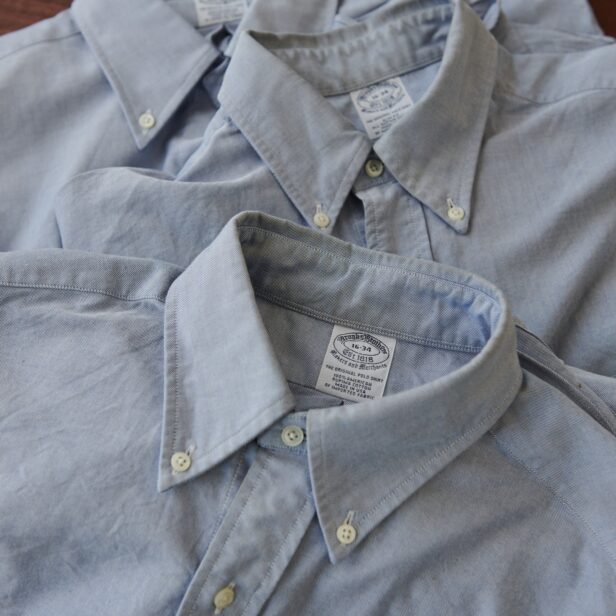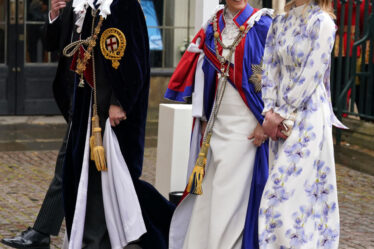
T
The Evolution of the Oxford Shirt
There are very few items of menswear that were created a century and a quarter ago, that if they were worn today in their original iteration would still look stylish and appropriate. However, the Oxford shirt is certainly one of them.
To be sure, men wore two and three-piece suits and neckwear in the early 1900s, as they do today, but would those pieces still look as relevant and current? Both have undergone significant changes to the point that experts can typically pinpoint their decade based on their style.
All to say, perhaps the Oxford shirt isn’t the only menswear that can lay claim to being as “in style” today as it was over a hundred years ago, but it must be considered a prominent member of that exclusive club.
The Origins of the Oxford Shirt
The Oxford shirt has a lengthy and full history, as well as significant evolution over its century of existence. It derives its name from the fabric it is made of, Oxford cloth, which gets its moniker from Oxford College. However, the college really had nothing to do with the creation of the cloth, other than lending its name. You see, in the latter half of the 19th century, a Scottish textile mill created different weaves of cloth and for marketing purposes named them after famous universities. There were Oxford, Cambridge, Yale, and Harvard weaves. The other three fabrics are historical footnotes now, but the Oxford cloth not only survived but thrived.
Oxford cloth is made from cotton threads and is distinguishable by its noticeable basket weave pattern. The pattern is formed by using an equal number of warp and weft threads. In textile weaving, the warp threads run vertically and weft threads run horizontally. This weave pattern gives Oxford cloth a number of characteristics that have contributed to its popularity, particularly as a shirting fabric. It combines both a softness and durability not often found in other fabrics. The basket weave pattern is breathable and is also somewhat naturally wrinkle-resistant. This is likely why Oxford shirts were originally used as sportswear.
In the late 19th century, shirts from the fabric became popular with British polo players due to their comfort and durability and, especially for those in British India, the coolness they provided. The combination of cotton and the Oxford weave’s breathability allow for air flow and the evaporation of perspiration.
The shirts were designed with pointed collars, similar in design to a classic men’s business shirt, but they were soft and lacked the stiffness of those shirts. As a result, during the active playing of polo the collars would flop around the player’s faces. To prevent this, the players began attaching buttons to their shirts to fasten the collar points. While its inception was practical, it was seen as a stylish addition.
Legend has it that someone from Brooks Brothers, maybe even the president John Brooks himself, attended a polo match in England, saw the shirts with their buttoned-down collars, and brought the concept back to America. Brooks Brothers is certainly credited with creating what we know today as the Oxford Cloth Button Down (OCBD) shirt.
The OCBD has some unique features that distinguish it from other shirt styles. It is, of course, made from Oxford cloth, but the construction of the collar is also significant. The collar is not only buttoned down but also soft and unlined. Keep in mind that when the shirt made its initial appearance, around 1900, many men’s dress shirts still had stiff, detachable collars.
Also, originally the collar did not button down flat against the shirt but formed a slight open roll or curl. Another common feature of the OCBD is a box pleat in the middle of the back, which allows greater movement – likely hearkening to its genesis as a sports shirt. It also had a breast pocket and a single button cuff sleeve.
The Oxford Shirt in Men’s Fashion
With little in the way of actual design changes to the shirt itself, the Oxford shirt managed to go through several evolutions of fashion style after its initial — and successful — introduction by Brooks Brothers. Businessmen first adopted the OCBD as an alternative dress shirt for the professional who wore a suit. The soft, rolled collar was a more comfortable alternative to the stiff collars of the day. So, if not quite formal, it was at least proper business dress.
Soon after, celebrities embraced it, wearing it as often with a tie as without. Some notable style icons who popularized the shirt, included Fred Astaire and Miles Davis. This began its evolution to a more casual style. However, by mid-century, it became most associated with college students, particularly in the Ivy League. This development saw the shirt become even more casual, paired with chinos and sports jackets or tweeds, rather than two-piece suits. During the growth of the suburbs in the 1950s, the OCBD shirt was the unofficial uniform for backyard barbecues and casual weekend get-togethers.
Rather than diminish its popularity, its use in casual dress only seemed to increase it, as it showed the versatility of this classic piece of menswear. This fuels the current discussion of whether the Oxford is a casual dress shirt, or a dressy casual shirt. Today the shirt appears as equally proper under two-piece business suits as it does with jeans. While still a casual look, it dresses up jeans or chinos, making it appropriate for anything from a weekend with friends to a first date lunch. (Though if the first date is dinner, a jacket is still recommended.)
For most offices today, while you want to maintain a professional look, we’ve moved away from the formality of a three-piece suit, or a business suit worn with French cuffs requiring cuff links. The Oxford shirt, paired with a suit, may be the perfect way to maintain a professional look, while achieving the less formal style often seen in today’s workplace.
The Oxford Shirt Today
Currently, menswear companies offer an Oxford shirt. Interestingly, the original creator of the OCBD, Brooks Brothers, began to stray from the formula in the 1980s. They made more and more changes to the shirt, including eventually lining and fusing the collar, to the point where some considered the shirt they made was no longer an Oxford button-down.
Several other companies, such as Mercer & Sons, and Wythe, began stepping in to fill the niche and made their shirts like the original. Brooks Brothers themselves even went back to their famous design and there are probably more menswear manufacturers now making Oxford shirts than ever.
When it comes to colors and patterns of an Oxford shirt, most people think of a solid white or blue. Those two have been around since the beginning and are very versatile for wardrobe use. However, there are a wide variety of colors and patterns that can be found in Oxford cloth. The colors and patterns are only limited by the imagination of the textile mill making the fabric. An Oxford shirt can look especially pleasing in a vertical stripe, which, after the obligatory white and blue shirt, is a must have for the wardrobe. The basket weave pattern of Oxford cloth lends itself quite well to a variety of styles.
If you do not already have an Oxford shirt as part of your wardrobe, consider adding one. If you already have one and tend to wear it the same way all the time, try changing it up. If you always wear it with slacks and a sport coat for business casual, add a tie to dress up the look. Alternatively, pair it with your jeans and leather jacket, or no jacket at all, to catch the game with your friends. This versatility is why this menswear staple is generally considered a must-have for the man who wants to dress well and look good.
Deviations From the Original
The Oxford shirt continues to evolve, and some shirts marketed as Oxfords today may not seem to fit the classic definition. While the traditionalist will insist the Oxford shirt be made from 100% cotton, with a soft, button-down, roll collar, and a center box pleat in the back, today many shirts without all of these characteristics are called Oxford shirts.
One of the most common deviations from the Oxford’s inception is fabric — specifically cotton-polyester blends. Polyester is much maligned by purists, but polyester yarns have come a long way over the last several years, and they can be very soft, durable, and quite wrinkle-resistant. There is a tendency to criticize their use, but they are growing in popularity, even among some of the higher-end menswear producers. Despite polyester’s improvements and increased use, cotton is still generally preferred.
While most commonly associated with the button-down collar, not all Oxford shirts are button-downs. Technically, any shirt made from Oxford fabric is an Oxford shirt. There are even different varieties of Oxford cloth, though the weave should largely remain the same. The variation tends to come from the fineness of the cotton yarn or threads. Some of the more familiar types of Oxford cloth are Plain Oxford, often just called Oxford, Pinpoint Oxford, and Royal Oxford, with each using successively finer yarn. While the OCBD is generally seen as a casual shirt more comfortably paired with a sports coat, a point collar shirt made with Royal Oxford cloth would be right at home under a two-piece suit.
It is also quite common to see Oxford shirts without box pleats in the center back, opting for side pleats or darts. There are even some short-sleeved shirts with button down collars sold as Oxfords, though many would argue if a short-sleeved shirt can legitimately be called an Oxford. However, at a minimum, an Oxford shirt must be made from Oxford cloth. No matter how much evolution you are comfortable with, there has to be something that remains of the original.
Why the Oxford Shirt Remains a Classic in Men’s Fashion
The Oxford shirt in its many variations continues to be a menswear staple and should find a home in your closet as well. Their durability lends to their comfort, in that they tend to get softer and more comfortable with age and use and that durability also allows them to last longer without fraying and wearing.
For well over a century the Oxford shirt has been a wardrobe staple as both a trend setter and a style leader. It is equally as popular with celebrities and style icons as it is with university students and businessmen. The shirt’s future is only limited by technology and fashion itself; if its popularity continues, it is likely we will be wearing and discussing the Oxford shirt another hundred years from now.






